Saint Leo University CSI Summer Camp Offers High School Students Opportunity to Learn More About Criminal Justice Careers
Interdisciplinary Approach Tackles Fingerprinting, Human Remains, Evidence Documentation at Saint Leo University.
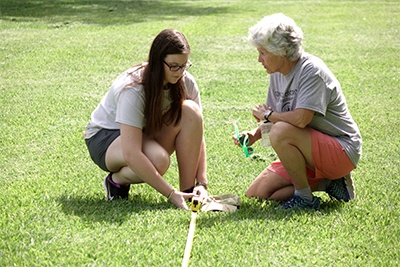
Interdisciplinary Approach Tackles Fingerprinting, Human Remains, Evidence Documentation at Saint Leo University.

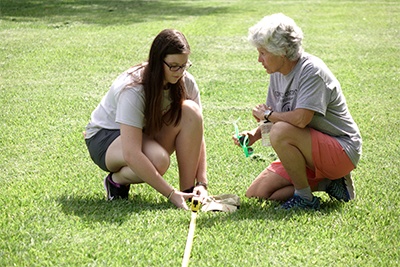 It's different than what you see on TV. It's not glamorous. It's hot. It's stinky. It's gross. It's hard work.
It's different than what you see on TV. It's not glamorous. It's hot. It's stinky. It's gross. It's hard work.
High school students learned about forensics during Crime Scene Investigation Summer Camp at Saint Leo University, from June 24 to June 29.
The students are learning that unlike television shows such as Law and Order: SVU, CSI, and Criminal Minds, crime solving takes a lot of effort—and time. Most crimes are not neatly solved in an hour (plus commercial breaks).
This is the first time Saint Leo has offered the CSI Summer Camp, which was for youths
ages 15 to 18. The camp provided students a hands-on and behind-the-scenes look at evidence collection, documentation, and preservation as they processed a variety of mock crime scenes.
Students got a taste of history, science, math, geography, civics, and more as they learned crime-solving techniques. Saint Leo University boasts a thriving criminal justice program, and spurring an interest in high school students was just one of the goals of the CSI Summer Camp.
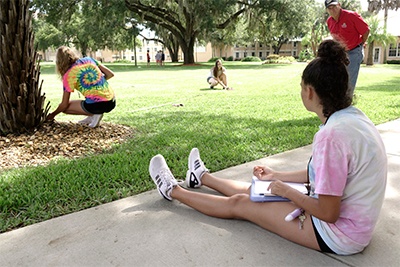 The camp takes an interdisciplinary approach, said Dr. Robert Diemer, director of Saint Leo's Department of Public Safety Administration and a criminal justice professor. "They find that they will use STEM skills—especially math and science," Diemer said. But crime scene investigation involves much more, including using their senses and taking notes, which encompasses English and writing.
The camp takes an interdisciplinary approach, said Dr. Robert Diemer, director of Saint Leo's Department of Public Safety Administration and a criminal justice professor. "They find that they will use STEM skills—especially math and science," Diemer said. But crime scene investigation involves much more, including using their senses and taking notes, which encompasses English and writing.
Saint Leo University criminal justice instructor Charlotte Braziel, a 26-year FBI veteran, asked the students about their "love" of algebra. Only one hand shot up, indicating the student is a fan of the math component. Braziel had the students looking for the X baseline and the Y before she set them loose on a "crime" scene outside of Kirk Hall.
She cited the Florida Highway Patrol as some of the best at sketching and measuring crime scenes. "It's hard work," she said. "People don't think CSI is hard. I'm passionate about it. And it is fun."
Braziel described a "cold" case or long-unsolved crime. "The daughter [of the crime victim] said, 'I've waited 25 years for this,' " Braziel said about solving the armed robbery and slaying of the woman's father. "That moment carries you through. You can't measure that. This is why we do what we do."
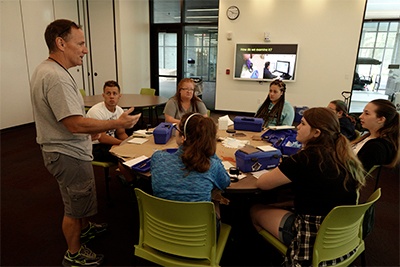 Dr. Robert "Bobby" Sullivan, assistant professor of criminal justice, gave students a little history and geography lesson by questioning them about the lifetime of fingerprints. He pointed to Qumran on the map. "What makes it famous?" he asked. Camper Samantha Stephenson answered, "that's where the Dead Sea Scrolls were found," and she was correct. Discovered in 1948, the scrolls bore fingerprints that were about 2,000 years old, Sullivan said. But for fingerprints to last that long, they had to be in a certain environment. "Salty, dry air is perfect," he added.
Dr. Robert "Bobby" Sullivan, assistant professor of criminal justice, gave students a little history and geography lesson by questioning them about the lifetime of fingerprints. He pointed to Qumran on the map. "What makes it famous?" he asked. Camper Samantha Stephenson answered, "that's where the Dead Sea Scrolls were found," and she was correct. Discovered in 1948, the scrolls bore fingerprints that were about 2,000 years old, Sullivan said. But for fingerprints to last that long, they had to be in a certain environment. "Salty, dry air is perfect," he added.
Saint Leo's campers learned about the whorls, arches, deltas, loops, and cores of fingerprints. They learned how to "lift" a print, and how to compare a latent fingerprint (those found at a crime scene) with a known fingerprint (one taken in a controlled circumstance such as during an arrest). They also learned how to run the statistics on types of fingerprints. "A loop whorl is rare," Sullivan told them.
Braziel detailed documentation for the CSI campers. They measured and noted where items were found on a "crime scene" on the lawn of Kirk Hall. Braziel explained that the first photo taken is that of the log sheet, which records the case number, address, date, name of person who is taking the photograph, and the law enforcement agency's name. "Photo No. 2 [at a crime scene] is wide range," Braziel said. "And you take notes about every photo you take. In the John Gotti Jr. case, we were looking at cases [and photos] that were 20 or 25 years old. Those notes are important."
Joseph Cillo, assistant professor of criminal justice, and a former defense attorney, tied in what the students are learning and how it can be used in court.
Maggots, rigor mortis, and lividity aren't the nicest after-lunch topics, but the CSI campers learned about human remains from Sullivan and Dr. Karin May, assistant professor of criminal justice. Sullivan asked why insects on bodies are important. "They can help you determine the time of death depending on what stage [flies, larvae, maggots] they are in," student Jessaca Bristol said, correctly.
The stages of stiffening of the joints and muscles were up next. With four to eight hours of death, a body goes into pre-rigor mortis. At eight hours, the limbs are stiff and within 16 hours, rigor mortis starts to lessen as the body begins decomposing, Sullivan said.
"When you die, your blood pools at the lowest part of the body," Sullivan said. "It turns a dark pinkish color." That is livor mortis, also known as lividity or post mortem lividity, and it begins two to three hours after death. Lividity helps investigators determine not only when a death occurred, but often where—or more accurately, if a body has been moved.
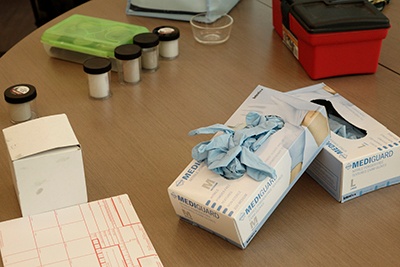 Saint Leo's CSI Summer Camp included a field trip to the Pasco County Sheriff's Office Forensics Services Section (FSS) where the students learned about latent prints and blood spatter, toured an evidence locker, and viewed a vehicle being processed for evidence by forensic experts.
Saint Leo's CSI Summer Camp included a field trip to the Pasco County Sheriff's Office Forensics Services Section (FSS) where the students learned about latent prints and blood spatter, toured an evidence locker, and viewed a vehicle being processed for evidence by forensic experts.
On Thursday and Friday, the students put their newly learned skills to the test. "The campers will process three mock crime scenes," said Nikki Heister, special programs manager for Saint Leo's School of Education and Social Services. Participants processed a scene at the university's "crime house," and human remains in the yard, and examined a van in the parking garage. "They will be collecting evidence, documenting it, photographing and sketching, and presenting to a mock grand jury," Diemer said. "It's a very hands-on learning experience."
Great 38/News Channel 8 reporter Anthony Allred covered the camp June 28 and put the students through their paces. They showed their skills at documenting evidence, marking the crime scene, and dusting for fingerprints.
But it was not all crime scene investigation for the campers as they experienced residence hall life while staying at Saint Leo along with movies, swimming, and time at the university's game room, and trips to Pin Chasers in Zephyrhills, the Escape Room in Tampa, and Xtreme Adventures in Land O' Lakes.
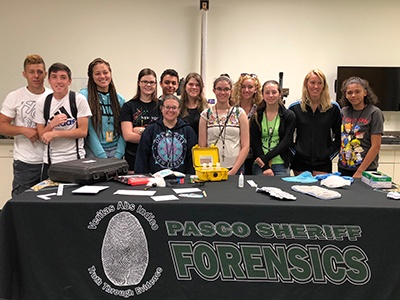 Most of the CSI campers expressed an interest in pursuing a career in criminal justice. "But this camp is a wake-up call," Sullivan said. "They realize it's not like TV. But they're finding out about areas of specialization, too."
Most of the CSI campers expressed an interest in pursuing a career in criminal justice. "But this camp is a wake-up call," Sullivan said. "They realize it's not like TV. But they're finding out about areas of specialization, too."
Two of Saint Leo's most popular criminal justice specializations are forensics and homeland security, Sullivan noted. The university offers bachelor's and master's degrees in criminal justice with several specializations including criminalistics; behavioral studies; corrections; forensic science; legal studies; and critical incident management.
And new this year, Saint Leo has added the Doctor of Criminal Justice (DCJ) degree program. The DCJ: Homeland Security is for those students who wish to advance in administration, and perhaps lead a law enforcement agency or office. Another specialization, the DCJ: Education, provides graduate-level courses to prepare individuals for a teaching or training career; graduates from either specialization will be qualified to teach criminal justice at the college level.
Saint Leo also boasts some impressive criminal justice alumni: Atlanta (Georgia) Police Chief Erika Shields as well as former Chief George Turner; former Tampa Police Chief Eric Ward; Hillsborough County Sheriff Chad Chronister; Bradenton Police Chief Melanie Bevan; Lakeland Police Chief Larry Giddens; and Corpus Christi (Texas) Police Chief Mike Markle; along with many other law enforcement leaders.
About Saint Leo University
Saint Leo University (www.saintleo.edu) is a modern Catholic teaching university that is firmly grounded in the liberal arts tradition and the timeless Benedictine wisdom that seeks balanced growth of mind, body, and spirit. The Saint Leo University of today is a private, nonprofit institution that creates hospitable learning communities wherever students want to be or need to be, whether that is a campus classroom, a web-based environment, an employer's worksite, a military base, or an office park. Saint Leo welcomes people of all faiths and of no religious affiliation, and encourages learners of all generations. The university is committed to providing educational opportunities to the nation's armed forces, veterans, and their families. Saint Leo is regionally accredited to award degrees ranging from the associate to the doctorate, and the faculty and staff guide all students to develop their capacities for critical thinking, moral reflection, and lifelong learning and leadership.
The university remains the faithful steward of the beautiful lakeside University Campus in the Tampa Bay region of Florida, where its founding monks created the first Catholic college in the state in 1889. Serving more than 13,000 students, Saint Leo has expanded to downtown Tampa, to other sites in Florida and beyond, and maintains a physical presence in seven states. The university provides highly respected online learning programs to students nationally and internationally. More than 94,000 alumni reside in all 50 states, in Washington, DC, in three U.S. territories, and in 76 countries.
Media Contact:
Mary McCoy, University Writer & Media Relations, mary.mccoy02@saintleo.edu, (352) 588-7118 or cell (813) 610-8416